 
Sicard SM-4 Sanivan
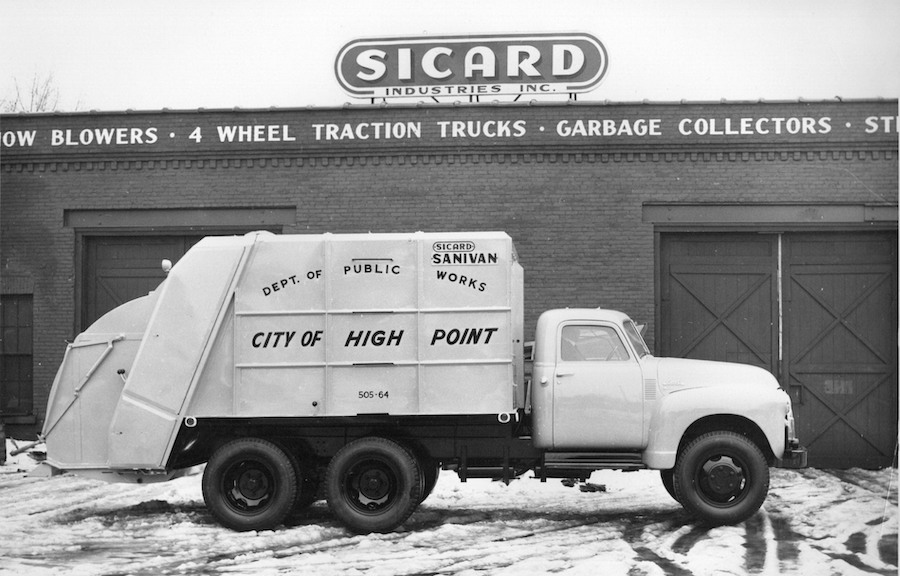
The SM-4 Sanivan was another design from Ronaldo Boissonnault, replacing the SM-3 in 1950. The tri-panel folding ejector remained the same as the SM-3, but was joined by a tilt-to-dump version, designated SM-4D. The ejection models were a mere 200 pounds heavier than the SM-4D. The big change came in the form of a new packing panel, which now travelled completely within the side walls of the tailgate structure. The gear and sector driving the packing panel were also eliminated, exchanged for a more direct rod and crank arrangement. The new tailgate design is shown in the diagrams below.
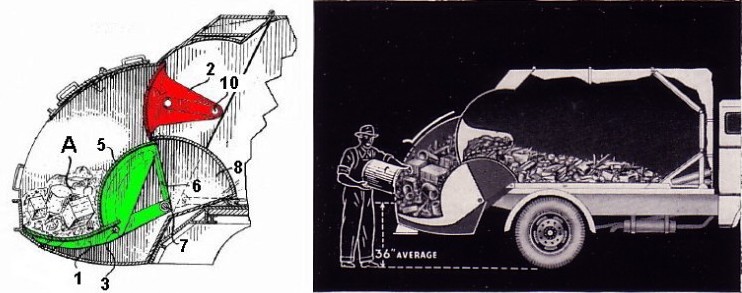
Loading Position
Packing panel 1 rests on floor of tailgate structure, and includes curved vertical section 5, reinforcing braces 6, and pins 3 which protrude through side walls. Packing panel assembly forms trough, pivotable on bearing 7. Retainer panel 2 is pivotable on bearing 10, and rests in lowered position effectively blocking passageway into body. Refuse A is loaded on to surface of packing panel assembly.
|
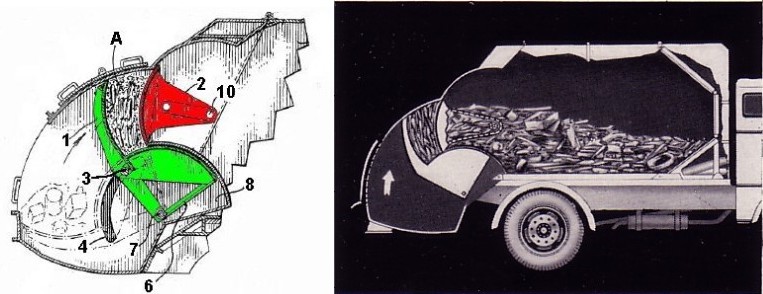
First Stage
Operator commences cycle by pulling and holding control lever for packing panel 1, causing rotation upward through the hopper. Hydraulic cylinders (not shown) pull pins 3 upward through arcuate slots in side wall 4, while packing panel assembly pivots into cavity 8 within tailgate. As the packing panel rises, the load A is squeezed against the rear face of retainer panel thereby crushing bulky items.2. When maximum pressure is achieved (a hydraulic pressure gauge was provided), packing panel stops, and the lever is then released.
|
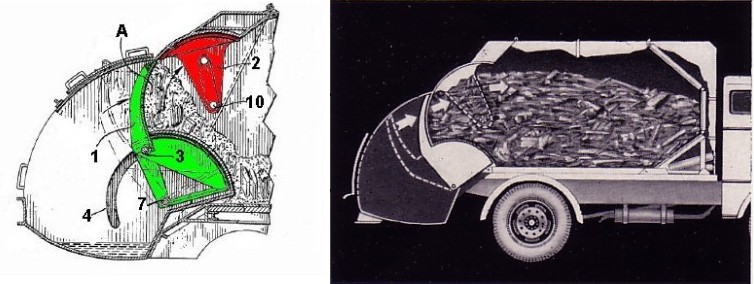
Second Stage
Operator next pulls lever controlling retainer panel 2, which raises the panel and opens the passageway from the hopper to the storage body. The packing panel 1 is then further actuated, pushing the pre-crushed load A into storage body until it reaches it's maximum travel limit. Lever is released, which stops packing panel in this position.
|
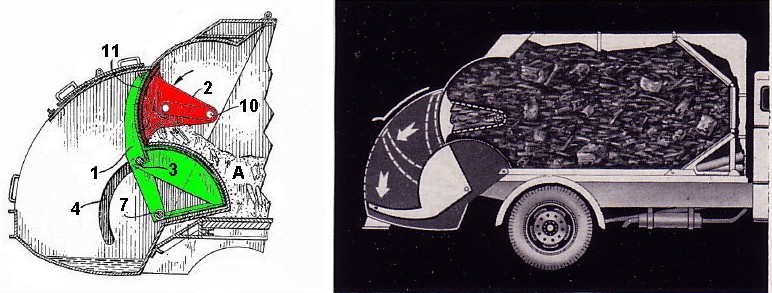
Final Stage
Operator reverses retainer panel 2, thereby closing off passageway and scraping the forward face of packing panel 1. Compacted load is now retained in body, and packing panel may be reversed through hopper to the loading postion.
|
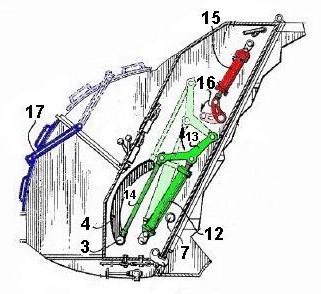 SM-4 Exterior Components
SM-4 Exterior Components
Side view at left shows tailgate with inspection covers removed, revealing packing panel cylinders 12 which act against bellcrank 13, which in turn pulls rod 14 connected to packing panel assembly at pin 3. The broken line drawing (light green shaded) shows the cylinder and linkage in the "packing panel raised" position, with travel following path of slots 4.
Much like the SM-3, cylinders 15 directly pivot retainer panel shaft using short bellcranks 16, shown in panel open/closed positions.
A sliding closure door 17 seals off hopper opening, and was designed to be closed during packing cycle. As previously noted, a hydraulic oil pressure gauge was mounted on the tailgate (not shown) to indicate when individual panels had reached maximum travel.
|
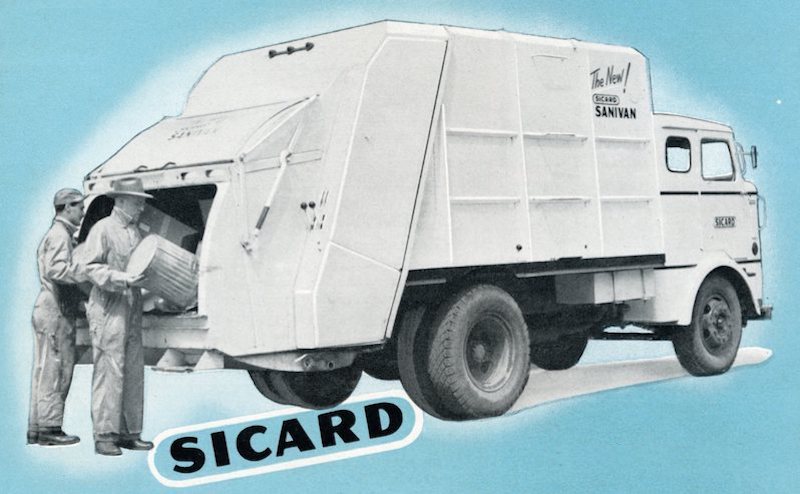
1950 Sicard SM-4 Sanivan on Sicard T-series truck chassis
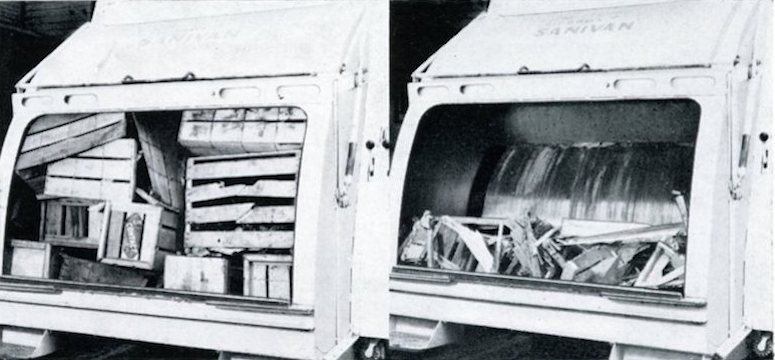
Before and After; the results of the SM-4 pre-crushing system
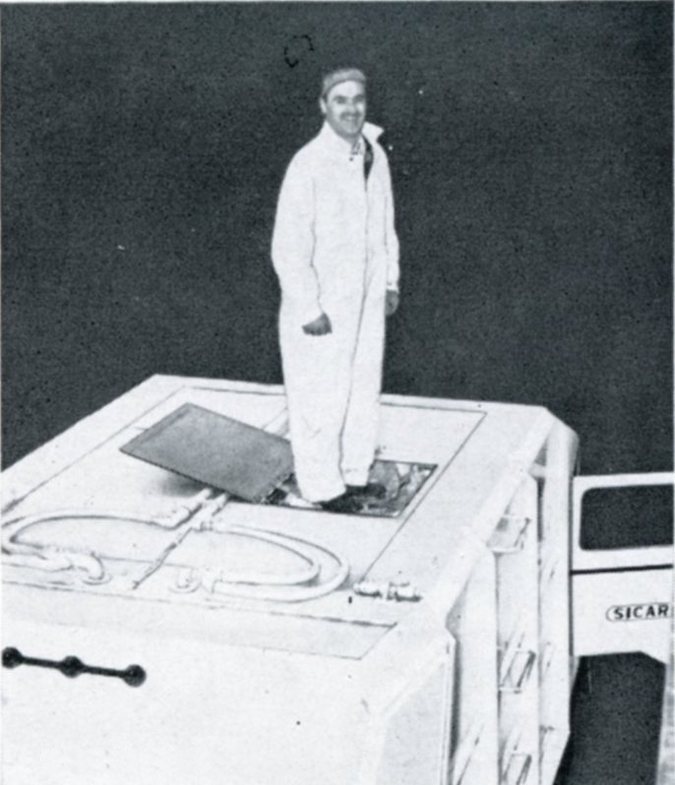
Load is packed solid; crewman stands on compacted refuse through open roof hatch
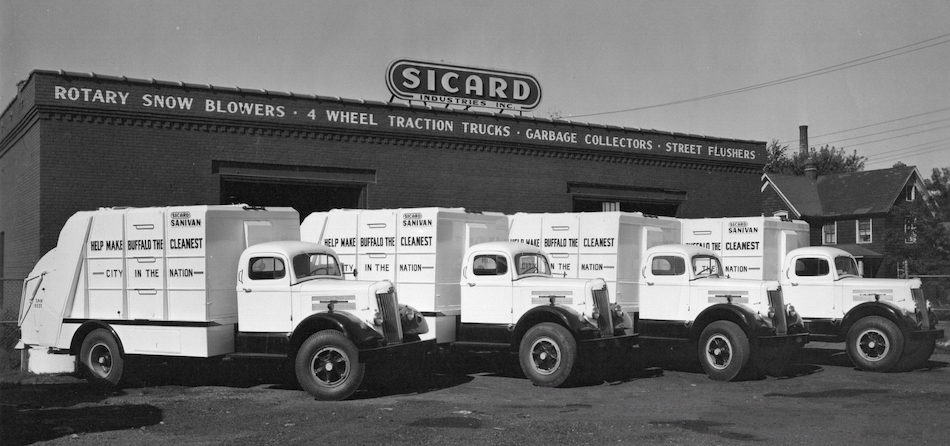
A fleet of SM-4 Sanivans ready for delivery to Buffalo, 1950
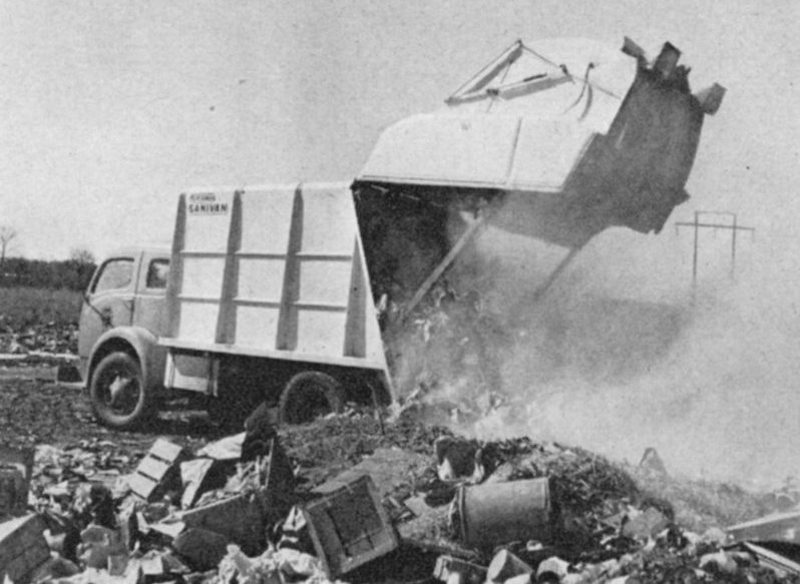
City of Midland, Michigan SM-4 unloading at a landfill, 1951
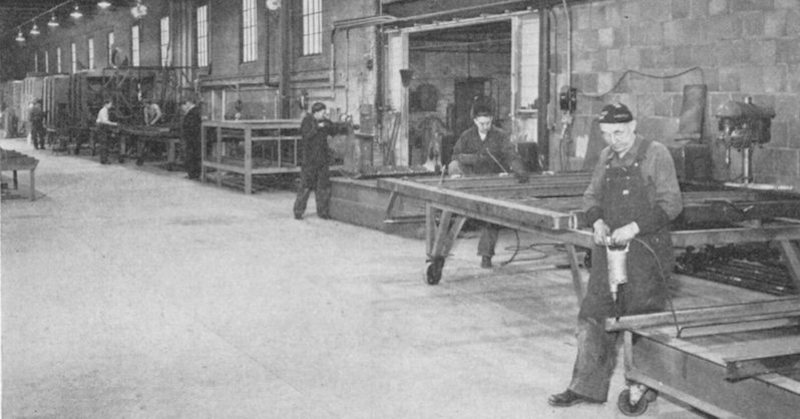
Building SM-4s at the Watertown factory, 1950
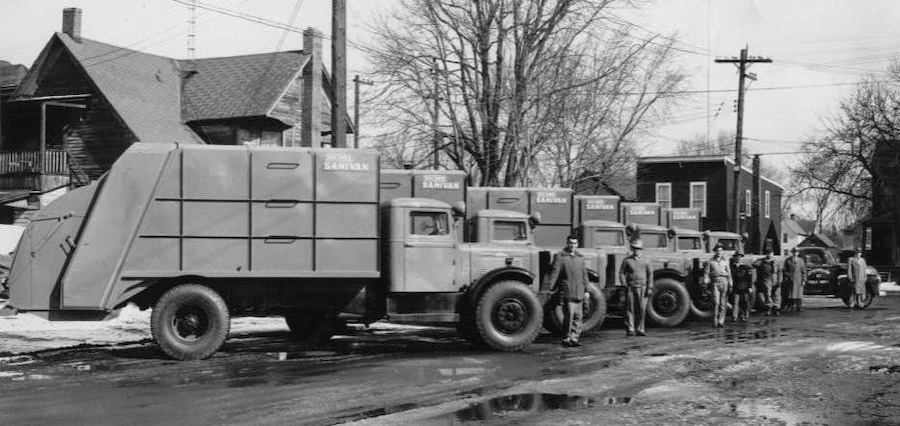
1953: A fleet of SM-4 Sanivans on Brockway trucks, sold to Rochester, New York and awaiting shipment at the Watertown factory
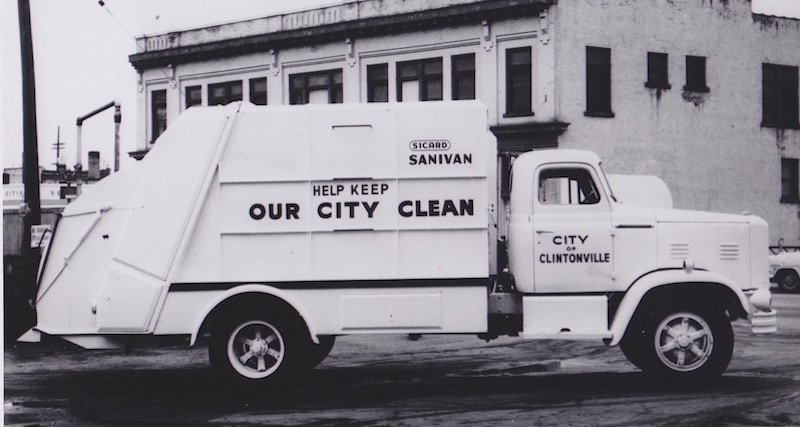
City of Clintonville, Wisconsin Sanivan on a FWD truck chassis
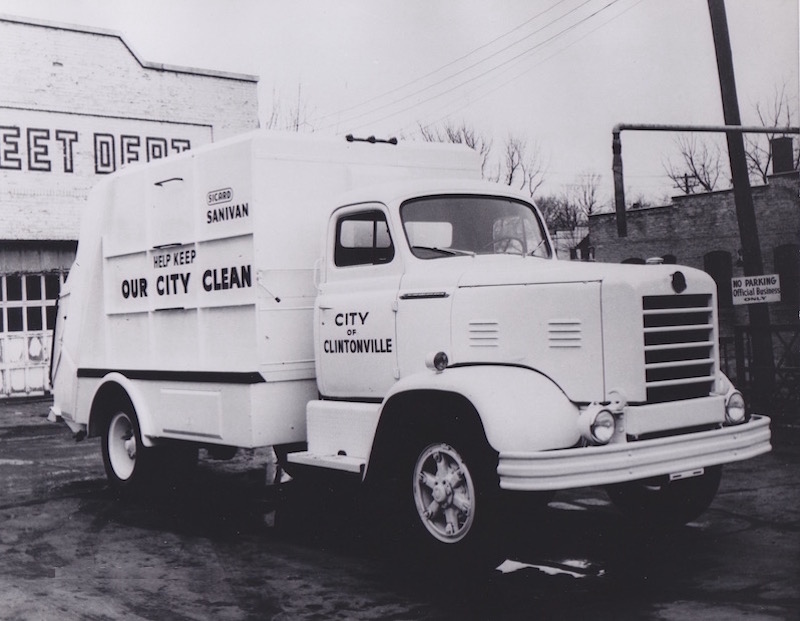
Clintonville was the home of the FWD truck factory
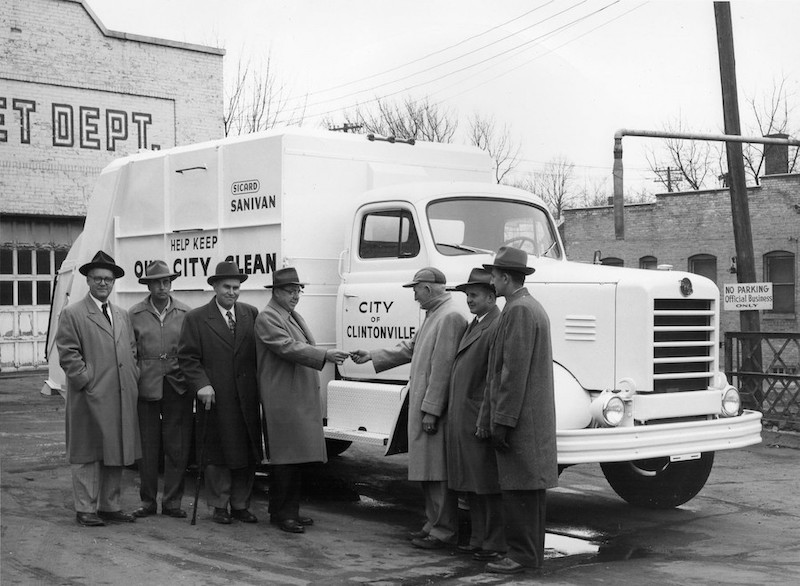
Clintonville officials, and most likely the Sicard distributor salesmen
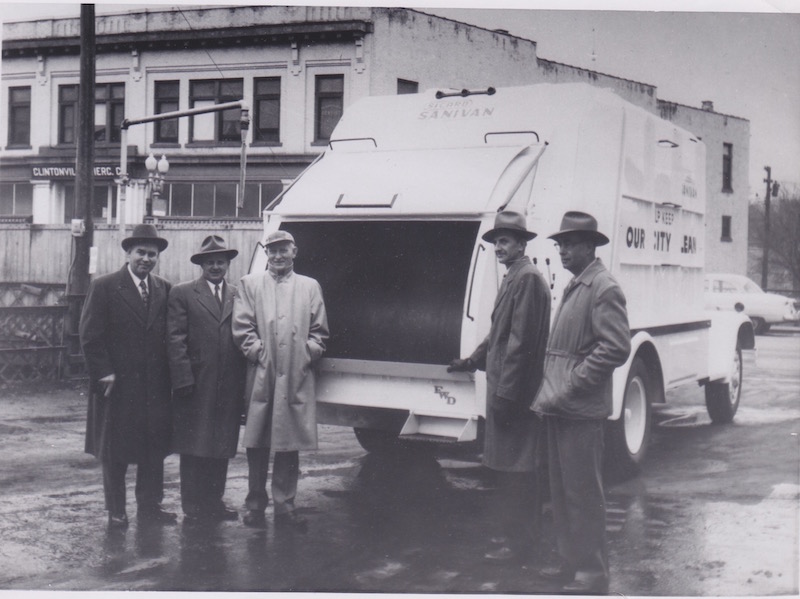
The business end of Clintonville's new Sanivan
In 1968, Sicard was bought by Pacific Car & Foundry (PACCAR), at which time the Sicard motor truck line was phased out. Presumably, this spelled the end of the Sanivan as well. The last known trade ad for the SM-4 was from 1964. Although effectively obsolete by the mid-1960s, the Sanivan boasts a host of achievements in refuse truck design that have had a major influence on the industry, both then and now. Sicard and Boissannault's designs are cited in the patents of the Heil Colectomatic, Daybrook Power-Packer and Leach Packmaster. Below is a comparison of Sicard features with some well-known North American refuse truck designs:
|
Feature or Concept |
On Sicard |
On Others |
|
|
Direct hydraulic ejection panel in a rear loader |
1943 |
Eagle Compressmore (1938), Heil Colectomatic Mk.II (1960) |
| |
Concept of progressive packing against ejector panel in a rear loader |
1943 |
Heil Colectomatic Mk.II (1960) |
| |
Cross-mount blade cylinders |
1945 |
Used on packing panels of many modern front and side-loaders (since circa 1960) |
| |
Use of guide rollers and tracks to guide oscillating packer blade |
1943 |
Leach Packmaster (1947) |
| |
Concept of in-hopper pre-crushing in a rear loader |
1945 |
Herman/Daybrook (1954), Dempster Route King (1970) |
| |
Pivoting hinged hopper in a rear loader |
1950 |
Heil Colectomatic (1953) |
| |
Builder of complete refuse packer truck including cab and chassis (North America) |
1940s |
Gar-Wood T-100 (1965), Lodal Evo (1968) |
|
This does not take away from the models above, which are superb designs in their own right. It merely emphasizes that while Sicard never became a giant among refuse body builders, they had an important influence on the industry beyond the decade of their involvement in it. Indeed, the SM-4 Sanivan looks strikingly modern even today, closer in appearance to a modern rear loader than any of its contemporaries of the early 1950s. It was perhaps, a classic case of a design being too far ahead of its time!
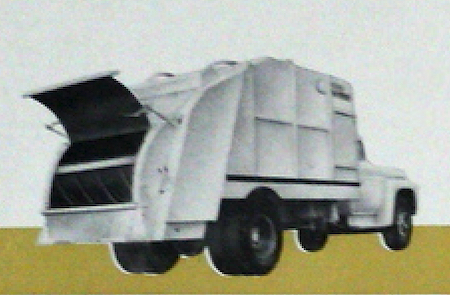
From a 1964 Sicard brochure; the latest mention of the SM-4 Sanivan model
Sincere thanks to Joan Wells of Sicard, division of SMI-Snowblast, who provided information used in the preparation of this article.
REFERENCES
Vintage Sicard Literature in PDF at the Classic Refuse Trucks Library
Vintage Sicard Advertising at the Classic Refuse Trucks Library
|
SELECTED PATENTS
|
Patent # |
Description |
Inventor |
Assignee |
Date |
|
US22561608 |
Load collecting refuse vehicle and packing device therefor |
Boissonnault |
Sicard |
March 24, 1950 |


11/6/04 (revised 12/13/20)
© 2004, 2020
All Rights Reserved
Photos from factory brochures/advertisements except as noted
Logos shown are the trademarks of respective manufacturers
|
|
| 
















 SM-4 Exterior Components
SM-4 Exterior Components